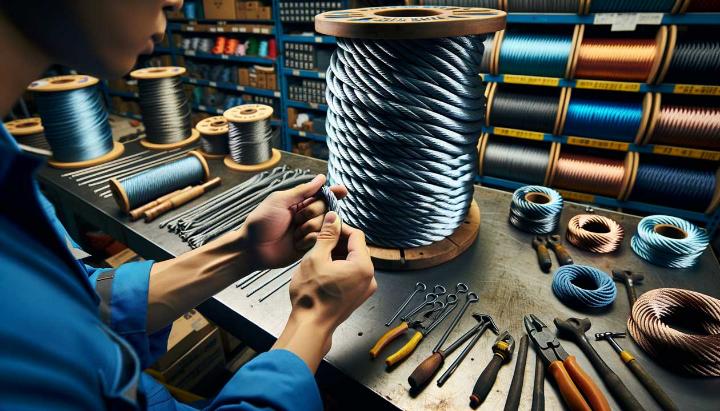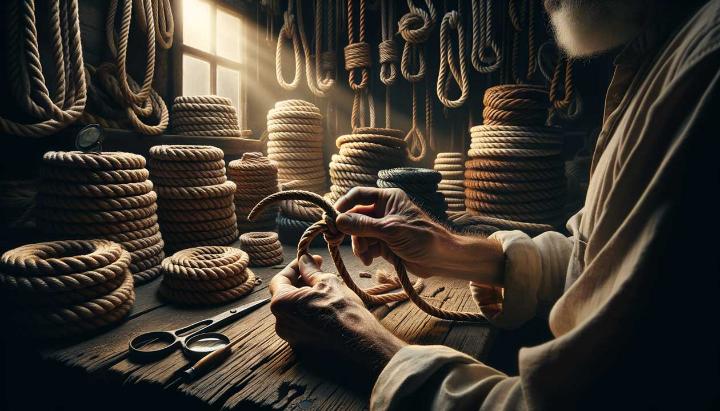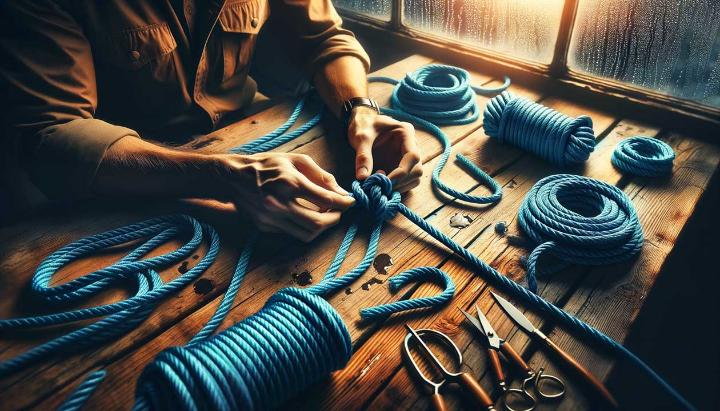Have you ever wondered how a simple rope loop could mean the difference between success and failure in critical operations? From the dizzying heights of construction sites to the treacherous depths of offshore rigs, mastering the art of braid rope and wire rope loops is no trivial matter. At iRopes, we've revolutionised this age-old craft with our innovative high-strength rope technology.
Imagine a world where your rope loops are not just secure, but virtually unbreakable. A world where you can push the boundaries of what's possible, knowing your equipment won't let you down. That's the world we're creating at iRopes, and we're inviting you to be a part of it.
In this post, we'll dive deep into the intricacies of braid rope and wire rope loops, exploring their unique characteristics and applications. But more importantly, we'll unveil iRopes' game-changing loop creation technique that's setting new industry standards. Whether you're a seasoned professional or a curious newcomer, prepare to discover how our high-strength ropes are redefining reliability and performance across industries.
Ready to elevate your rope game? Let's unravel the secrets of mastering braid rope and wire rope loops, simplified.
Understanding the Basics of Braid Rope Loops
When it comes to securing loads or creating reliable attachments, braid rope loops are a go-to solution for many industries. Let's dive into the world of these versatile and strong rope configurations.
Types of Rope Splicing Techniques
Rope splicing is an art that transforms a simple length of rope into a functional tool. There are several techniques to create loops, each with its own strengths:
- Eye splice: The most common method, creating a strong, permanent loop at the rope's end.
- Ring splice: Used to attach a rope to a ring or similar fitting.
- Chain splice: Connects a rope directly to a chain, often used in marine applications.
Each of these splices maintains the rope's integrity, often resulting in a connection nearly as strong as the rope itself.
Creating an Eye Splice in Braided Rope
Creating an eye splice in braided rope requires patience and skill. Here's a simplified guide:
- Unravel the rope end, separating the core from the cover.
- Form the desired loop size and mark where the core will re-enter the rope.
- Using a fid, thread the core back into the rope at the marked point.
- Taper the core and cover ends, then tuck them into the rope body.
- Smooth out the splice and test its strength.
Remember, practice makes perfect. Don't be discouraged if your first attempts aren't flawless.

Step-by-Step Guide to Making a Rope Loop
While splicing is the preferred method for creating strong, permanent loops, there are alternative techniques:
- Bowline knot: A reliable knot that's easy to tie and untie, even after bearing a load.
- Figure-8 loop: A strong loop that's less likely to jam than some other knots.
- Alpine butterfly loop: Creates a secure loop in the middle of a rope.
Each method has its place, depending on the application and whether you need a permanent or temporary loop. Always consider the rope type, expected load, and environmental conditions when choosing your loop-making technique.
By mastering these basic techniques, you'll be well-equipped to create secure and reliable braid rope loops for a variety of applications. Remember, proper technique is crucial for maintaining rope strength and ensuring safety in all your rope-related tasks.
Exploring the Strength and Durability of Wire Rope Loops
When it comes to heavy-duty applications, wire rope loops are the unsung heroes of the industrial world. Their incredible strength and durability make them indispensable in various sectors, from construction to maritime operations. Let's dive into the fascinating world of wire rope loops and discover what makes them so robust and reliable.
Composition and Structure of Wire Rope
Wire rope is a marvel of engineering, combining flexibility with immense strength. Imagine a bundle of thin, high-strength steel wires twisted together to form strands, which are then wound around a core. This core can be made of fibre or steel, depending on the rope's intended use.
The secret to wire rope's strength lies in its construction:
- Strand arrangement: The number and pattern of strands affect the rope's strength and flexibility.
- Wire grade: Higher-grade steel wires offer superior tensile strength.
- Core material: Steel cores provide greater strength, while fibre cores offer more flexibility.
One innovation that's revolutionised the industry is the compacted strand wire rope. By compressing the outer strands, manufacturers create a rope with a smoother surface and greater strength-to-diameter ratio. It's like giving your wire rope a superhero suit!

Benefits of Using Wire Rope for Loop Creation
Why choose wire rope for your loop needs? Here are some compelling reasons:
- Exceptional strength-to-weight ratio: Wire rope loops can support massive loads without adding significant weight to the system.
- Durability in harsh conditions: They resist corrosion, abrasion, and fatigue, making them ideal for outdoor and marine environments.
- Flexibility: Despite their strength, wire rope loops can bend around sheaves and pulleys with ease.
- Predictable performance: Wire ropes are manufactured to strict standards, ensuring consistent quality and reliable breaking strength calculations.
When creating a wire rope loop, it's crucial to consider the safety factor. This is typically expressed as a ratio, such as 5:1, meaning the rope's breaking strength should be at least five times the maximum working load. Always err on the side of caution when calculating your safety factor – it's better to be over-prepared than under-equipped!
Industries Relying on Wire Rope Loops
Wire rope loops are the unsung workhorses in numerous industries. Let's take a quick tour:
- Construction: From crane operations to elevator systems, wire rope loops keep things moving safely.
- Mining: Deep underground or in open pits, these loops help extract valuable resources.
- Maritime: Mooring lines, rigging, and cargo handling all depend on the strength of wire rope loops.
- Oil and Gas: Offshore platforms use wire rope loops for various critical operations.
In each of these industries, the reliability of wire rope loops can mean the difference between a successful operation and a potential disaster. That's why understanding wire rope strength and choosing the right type for your application is so crucial.
Have you ever wondered how engineers determine the right wire rope for a job? It's not just about picking the thickest rope available. They consider factors like the expected load, environmental conditions, and the specific application. For instance, a wire rope loop used in a salt-water environment might require special corrosion-resistant coatings or materials.
Remember, while wire rope loops are incredibly strong, they're not invincible. Regular inspections and maintenance are essential to ensure they continue performing at their best. Keep an eye out for signs of wear, such as broken wires, kinks, or corrosion. When in doubt, always consult with a wire rope specialist – safety should always be your top priority!
iRopes' Innovative Loop Creation Technique
In the world of high-strength ropes, innovation is the key to unlocking new levels of performance and reliability. At iRopes, we've taken rope loop creation to the next level with our groundbreaking technique. Let's dive into how we're revolutionising the industry, one loop at a time.
High-Strength Rope Splicing Methods
Traditional splicing methods have served us well for years, but as rope technology advances, so must our techniques. At iRopes, we've developed a splicing method that's a game-changer for high-strength ropes. Imagine a splice so seamless, you'd swear the rope was born with the loop intact.
Our innovative approach combines the best of traditional eye splices with cutting-edge technology. We use a proprietary weaving technique that interlaces the rope's core and cover in a way that distributes load more evenly than ever before. The result? A loop that's not just strong, but also incredibly durable and resistant to wear.

But what sets our method apart isn't just the technique itself. It's the materials we use. We've partnered with leading manufacturers to source the highest quality Dyneema fibres, known for their incredible strength-to-weight ratio. When combined with our splicing method, the result is nothing short of extraordinary.
Advantages of Advanced Loop Creation
So, what does this mean for you and your rope needs? Let's break it down:
- Unparalleled strength: Our loops maintain up to 95% of the rope's original breaking strength, significantly higher than traditional methods.
- Enhanced durability: The unique weave pattern reduces wear and tear, extending the life of your rope.
- Improved flexibility: Despite its strength, the loop remains supple, making it easier to work with in various applications.
- Consistent performance: Our precision manufacturing process ensures each loop meets the same high standards, every time.
But don't just take our word for it. We've put our loops to the test in some of the most demanding environments imaginable. From offshore oil rigs battling fierce North Sea storms to elite mountain rescue teams in the Alps, our loops have proven their mettle time and time again.
Did you know? Our innovative loop creation technique has been independently tested and certified to exceed industry standards for load-bearing capacity and durability.
Whether you're in the maritime industry, construction, or outdoor adventure sports, our high-strength rope loops offer a level of reliability that's second to none. It's not just about creating a stronger loop; it's about giving you the confidence to push boundaries and tackle challenges head-on.
Ready to experience the iRopes difference for yourself? Reach out to our team of rope specialists today. We're not just selling ropes; we're offering peace of mind in the form of the most advanced loop creation technique in the industry. Let's work together to find the perfect high-strength rope solution for your unique needs.
Mastering the Art of Creating Secure Rope Loops
Whether you're an avid climber, a sailing enthusiast, or a professional rigger, mastering the art of creating secure rope loops is an essential skill. Let's dive into the world of knots and techniques that will elevate your rope work to new heights.
Essential Knots for Reliable Rope Loop Formation
The foundation of any secure rope loop lies in choosing the right knot. Here are some tried-and-true options that every rope enthusiast should know:
- Bowline knot: Often called the "king of knots," this versatile loop is easy to tie and untie, even after bearing a load. It's perfect for creating a secure, non-slip loop at the end of a rope.
- Figure-eight knot: A favourite among climbers and sailors, this knot forms a strong, stable loop that's less likely to jam than some alternatives. It's easily recognisable and inspectable, making it ideal for safety-critical applications.
- Overhand knot on a bight: When you need a quick, simple loop in the middle of a rope, this knot is your go-to solution. While not as strong as some other options, it's perfect for light-duty applications.
- Alpine butterfly knot: This versatile knot creates a secure loop in the middle of a rope that can be loaded in multiple directions. It's a staple in rope rescue techniques and mountaineering.
Remember, practice makes perfect. I once spent an entire rainy weekend mastering these knots, and it's paid dividends in my outdoor adventures ever since.

Techniques for Ensuring Loop Stability and Strength
Creating a secure rope loop isn't just about knowing the right knots; it's about understanding the factors that affect loop stability and strength. Here are some key considerations:
- Rope type matters: Different ropes behave differently. A knot that works well with a stiff climbing rope might not be ideal for a more supple sailing line. Always match your knot to your rope type.
- Tension is crucial: A loose knot is a weak knot. Always "dress" your knots by aligning the rope strands and removing any twists before tightening.
- Consider the environment: Wet conditions can affect rope behaviour and knot security. Some knots, like the bowline, can become less secure when wet, so choose accordingly.
- Regular inspections are key: Periodically check your loops for signs of wear or slippage. A quick inspection before each use can prevent potential disasters.
I learned the importance of these factors the hard way during a sailing trip when a poorly tied knot came undone in rough seas. It was a wake-up call that proper technique is non-negotiable when it comes to rope safety.
For more insights on mastering essential knots and splices for superior rope performance, check out our comprehensive guide on essential splicing tools.
Always test your rope loops under controlled conditions before relying on them in critical situations. A loop that fails during testing is a lesson learned; a loop that fails during use can be catastrophic.
To maintain your rope loops, store them properly when not in use. Avoid leaving them exposed to direct sunlight or harsh chemicals, which can degrade the rope fibres over time. And remember, if you're ever in doubt about the integrity of a rope loop, it's always better to re-tie it or replace the rope entirely.
Mastering secure rope loops is a journey, not a destination. Each knot you tie and each loop you create is an opportunity to refine your technique. So grab a piece of rope, start practicing, and watch as your confidence grows with every secure loop you form. Your future self (and your climbing or sailing partners) will thank you for the time you invest in honing this crucial skill.
Creating secure and reliable rope loops is essential for various applications, from securing loads to industrial tasks. Understand the key differences between braid rope loops and wire rope loops, including their distinct benefits and common uses. iRopes’ innovative loop creation technique enhances strength and durability, setting new standards in the rope industry. Whether you’re crafting a braid rope loop or a wire rope loop, iRopes provides cutting-edge solutions tailored to your needs, making us your go-to partner for high-strength ropes. Explore our advanced techniques and elevate your rope loop creations to the next level.
Interested in Our High-Strength Rope Solutions? Fill Out the Form Below:
If you're in need of high-quality rope loops for your specific applications, don't hesitate to use the inquiry form located above. Our team at iRopes is ready to provide you with customized, reliable rope solutions that meet your exact requirements.